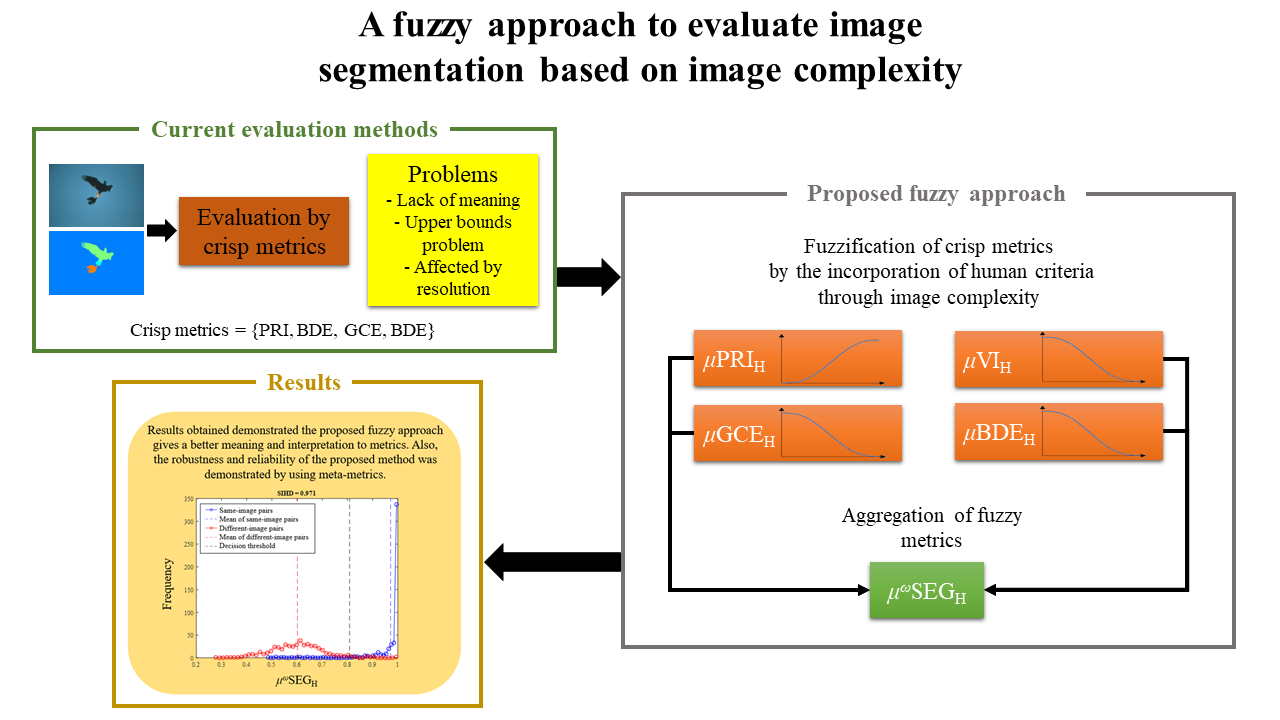A fuzzy approach to evaluate image segmentation based on image complexity
Keywords:
fuzzy evaluation, image complexity, image segmentation evaluationAbstract
Image segmentation evaluation may be carried out by comparing segmentation algorithm results with human ground truths. Its correct evaluation in benchmarks is important to promote the development of new and better segmentation algorithms. It may be partially considered a subjective task because each image may have multiple correct solutions. The evaluation is commonly carried out through crisp metrics, and they fail to generalize the subjectivity of the human criteria present in the human ground truths. Therefore, the interpretation and meaning of the metric values may be ambiguous. Thus, this paper presents a new fuzzy evaluation approach that considers the subjectivity of the human criteria by considering image complexity. This approach leads to an adequate evaluation of this subjective task. The proposed approach demonstrates its advantage when is evaluated using the Peng and SIHD meta-metrics achieving a performance of 0.795 and 0.971, respectively, outperforming the PRI, VI, GCE, and BDE metrics.
Downloads
References
T. Lei, P. Liu, X. Jia, X. Zhang, H. Meng, and A. K. Nandi, “Automatic Fuzzy Clustering Framework for Image Segmentation,” IEEE Trans. Fuzzy Syst., vol. 28, no. 9, pp. 2078–2092, 2020, doi: 10.1109/tfuzz.2019.2930030.
X. Jia, T. Lei, X. Du, S. Liu, H. Meng, and A. K. Nandi, “Robust Self-Sparse Fuzzy Clustering for Image Segmentation,” IEEE Access, vol. 4, no. 8, pp. 1–14, 2020, doi: 10.1109/ACCESS.2020.3015270.
T. Lei, X. Jia, Y. Zhang, S. Liu, H. Meng, and A. K. Nandi, “Superpixel-Based Fast Fuzzy C-Means Clustering for Color Image Segmentation,” IEEE Trans. Fuzzy Syst., vol. 27, no. 9, pp. 1753–1766, 2019, doi: 10.1109/TFUZZ.2018.2889018.
J. D. H. Resendiz, H. M. M. Castro, and E. T. Leal, “A Comparative Study of Clustering Validation Indices and Maximum Entropy for Sintonization of Automatic Segmentation Techniques,” IEEE Lat. Am. Trans., vol. 17, no. 8, pp. 1229–1236, 2019, doi: 10.1109/TLA.2019.8932330.
X. Chen and L. Pan, “A Survey of Graph Cuts/Graph Search Based Medical Image Segmentation,” IEEE Rev. Biomed. Eng., vol. 11, no. 1, pp. 112–124, 2018, doi: 10.1109/RBME.2018.2798701.
F. Kulwa et al., “A State-of-the-Art Survey for Microorganism Image Segmentation Methods and Future Potential,” IEEE Access, vol. 7, no. 1, pp. 100243–100269, 2019, doi: 10.1109/access.2019.2930111.
S. Poudel and S. W. Lee, “Deep multi-scale attentional features for medical image segmentation,” Appl. Soft Comput., vol. 109, p. 107445, 2021, doi: 10.1016/j.asoc.2021.107445.
C. Angela, W. Carolina, and C. Carlos, “Medical Image Segmentation Using the Kohonen Neural Network,” IEEE Lat. Am. Trans., vol. 17, no. 2, pp. 297–304, 2019, doi: 10.1109/TLA.2019.8863176.
R. Unnikrishnan, C. Pantofaru, and M. Hebert, “Toward objective evaluation of image segmentation algorithms,” IEEE Trans. Pattern Anal. Mach. Intell., vol. 29, no. 6, pp. 929–944, 2007, doi: 10.1109/TPAMI.2007.1046.
M. Simfukwe, B. Peng, and T. Li, “Fusion of measures for image segmentation evaluation,” Int. J. Comput. Intell. Syst., vol. 12, no. 1, pp. 379–386, 2019, doi: 10.2991/ijcis.2018.125905654.
Z. Wang, E. Wang, and Y. Zhu, Image segmentation evaluation: a survey of methods, vol. 53, no. 8. Springer Netherlands, 2020. doi: 10.1007/s10462-020-09830-9.
P. Arbeláez, M. Maire, C. Fowlkes, and J. Malik, “Contour detection and hierarchical image segmentation,” IEEE Trans. Pattern Anal. Mach. Intell., vol. 33, no. 5, pp. 898–916, 2011, doi: 10.1109/TPAMI.2010.161.
S. S. Chai, K. L. Goh, H. H. Wang, and Y. C. Wang, “Comparative evaluation of interactive segmentation algorithms using one unified user interactive type,” Int. J. Comput. Inf. Syst. Ind. Manag. Appl., vol. 11, pp. 142–150, 2019.
T. R. Farshi, J. H. Drake, and E. Özcan, “A multimodal particle swarm optimization-based approach for image segmentation,” Expert Syst. Appl., vol. 149, pp. 1–13, 2020, doi: 10.1016/j.eswa.2020.113233.
Z. Khan and J. Yang, “Image segmentation via multi dimensional color transform and consensus based region merging,” Multimed. Tools Appl., vol. 78, pp. 31347–31364, 2019.
S. Rovetta, F. Masulli, and A. Cabri, “The ‘Probabilistic Rand Index’: A Look from Some Different Perspectives,” Neural Approaches to Dyn. Signal Exch., vol. 151, no. 1, pp. 95–105, 2019, doi: 10.1007/978-981-13-8950-4_10.
J. Pont-Tuset and F. Marques, “Supervised Evaluation of Image Segmentation and Object Proposal Techniques,” IEEE Trans. Pattern Anal. Mach. Intell., vol. 38, no. 7, pp. 1465–1478, 2016, doi: 10.1109/TPAMI.2015.2481406.
Y. H. Nai et al., “Comparison of metrics for the evaluation of medical segmentations using prostate MRI dataset,” Comput. Biol. Med., vol. 134, no. 104497, pp. 1–12, 2021, doi: 10.1016/j.compbiomed.2021.104497.
B. Peng, L. Zhang, X. Mou, and M. H. Yang, “Evaluation of Segmentation Quality via Adaptive Composition of Reference Segmentations,” IEEE Trans. Pattern Anal. Mach. Intell., vol. 39, no. 10, pp. 1929–1941, 2017, doi: 10.1109/TPAMI.2016.2622703.
L. Madrid-Herrera, “Algoritmo para determinar la complejidad de imágenes aplicado a segmentación,” Tesis de doctorado, Instituto Tecnológico de Chihuahua, México, 2022.
M. Versaci and F. C. Morabito, “Image Edge Detection: A New Approach Based on Fuzzy Entropy and Fuzzy Divergence,” Int. J. Fuzzy Syst., vol. 23, no. 4, pp. 918–936, 2021, doi: 10.1007/s40815-020-01030-5.
R. Soleymani, E. Granger, and G. Fumera, “F-measure curves: A tool to visualize classifier performance under imbalance,” Pattern Recognit., vol. 100, no. 107146, pp. 1–19, 2020, doi: 10.1016/j.patcog.2019.107146.
T. Lei, X. Jia, Y. Zhang, L. He, H. Meng, and A. K. Nandi, “Significantly Fast and Robust Fuzzy C-Means Clustering Algorithm Based on Morphological Reconstruction and Membership Filtering,” IEEE Trans. Fuzzy Syst., vol. 26, no. 5, pp. 3027–3041, 2018, doi: 10.1109/TFUZZ.2018.2796074.
D. Comaniciu and P. Meer, “Mean shift: A robust approach toward feature space analysis,” IEEE Trans. Pattern Anal. Mach. Intell., vol. 24, no. 5, pp. 603–619, 2002, doi: 10.1109/34.1000236.


